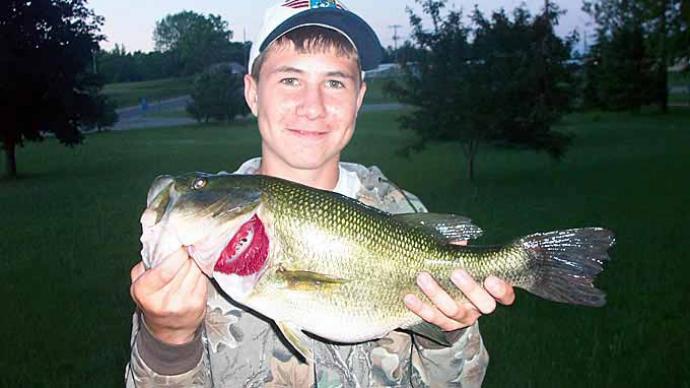Remember the July-August issue of Pond Boss? The lead feature was an intriguing story, steeped in history, about Richmond Mill Lake, near Laurel Hill. North Carolina. Owned by the Morgan Company, 120 acre Richmond Mill Lake is traveling toward an appointment with its destiny.
The story continues. While few pondmeisters have the desire to follow footsteps of the path this lake is taking, it's good reading...to see people thinking 'outside the box' to define a new cutting edge paradigm in pond and lake management.
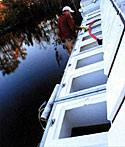
As President of the Morgan Company, Dr. Jim Morgan has some decisions to make. But, the decision to stock and manage the lake wasn't that tough. "We knew we wanted to do something different than most people, and the stocking decision was fairly easy." It's the business to follow the stocking that is taking time. "We have been thinking strongly about starting a world class fishing club and there are so many opportunities out there we have decided to look at a number of them, before deciding what to do," Dr. Morgan says. Sounds prudent.
What that means is engaging a stable of consultants looking at different business models and surrounding himself with knowledgeable people with experience to guide the Morgan Company into the best business decision for the lake. That's certainly outside most boxes.
Back to the stocking and management plan.
Morgan knows the lake needs to be a premier largemouth bass lake. He believes the lake deserves it. A lake built in 1835 with a history of helping people during the Civil War. a flowing resource which powered different mills for so many years deserves a grand fate. So, he employed yours truly to consult and help create a stocking plan. After defining a few goals, the follow-up recommendations made sense to Morgan and his property manager, Dave Buhler. Buhler is the on site, go to man to get things done. He negotiates contracts and oversees day to day operations for pine straw harvesting, farming, logging and other agricultural interests Morgan Company has. Buhler says. "The lake is such a focal point, so big and historically rich, we need to properly care for it."
Part of the problem is the fact the lake spills so much tea-stained colored water over the spillway, fisheries management has always been an issue. Throw in the fact the black water has a pH of 5.3, and there are more than the average management issues to contend. Fast flowing water, some 7-9,(KX) gallons a minute flowing through and over the expensive, U-shaped concrete spillway presents its own unique set of standards.
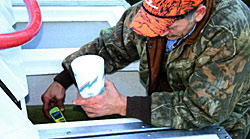
A number of biologists have advised the Morgan Company not to expect much from the lake. Water is too sterile and too acidic. But. Jim Morgan wasn't buying into it. "We have caught a number of large bass over the years. One guy caught a huge double digit monster not long before we drained the lake four years ago, just before we started to work on the dam."
As I pondered the situation, several key things struck me. The best way to beef up production of a lake as this is to feed the fish. Another way to beef up the fishery is to stock game fish which will eat fish food. The plan began to come together. It's quite fascinating to say the least.
Here's the plan we chose, then fulfilled. We brought two giant truckloads of fish, and stocked them at the same time. Don't worry, there's plenty of reasoning, as you will see.
After the State of North Carolina gave its blessings to close the gates on the dam late in the summer, Richmond Mill Lake was ready to re-fill. But, no. Big valve regulated gates filled with floating debris, and it would take several months to remove it. Finally, in winter months, with the help of a late season storm, five inches of rain in the watershed fill the lake in less than a week. That's lots of water, folks. As water began to caress long standing bare soils, terrestrial vegetation was inundated. Ray Scott's famous Legacy Lake's "Glory Hole" structure prepared to do its underwater job.
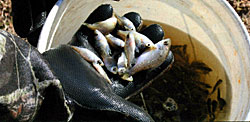
Time for fish. We stocked roughly I.(XX).(XX) fathead minnows, or 2,(XX) pounds. The minnows were small. Their job is to migrate around the lake, spawn once or twice, and not survive much longer than a year. 125,000 bluegill were stocked, ranging in size from two to five inches. Both coppernose and native strains of bluegill were stocked. 30,000 redear sunfish were stocked. Then, we added 6.000 pounds of largemouth bass trained to eat pelleted fish food. The bass averaged 2.2 pounds and ranged in size from 1.75 to 3.4 pounds. Several weeks later, we stocked 1,000 pounds of known Fl largemouth along with good numbers of one to two pound bass from Ray Scott's President's Lake, a lake made famous by its huge fish.

Here's where the fun began. We are convinced the lake will thrive best if fish are fed regularly. The Morgan Company contacted Zach Sweeney. of Sweeney Feeders in Boerne, Texas. The reason Sweeney was chosen was their willingness to follow the program to "think outside the box." With that many fish, filling and maintaining feeders would not be an easy task. Buhler was concerned. "Filling lots of feeders takes lots of time, and we wanted to work with a company who would help us solve problems and be most efficient." Zach Sweeney was up to the task. Here's where it gets really cool. Sweeney and his chief engineer, Dave Atkinson, designed a cutting edge, state of the art feeding system for Richmond Mill. They delivered and set 25 scatter feeders with a capacity to hold more than 200 pounds of floating fish food, another 15 directional feeders which hold 50 pounds each, and 10 vibratory feeders, to feed tiny morsels in shallow water to newly hatched sunfish and minnows. Each feeder sits on a stainless steel, adjustable platform in the lake. The vibratory feeders hang from a stainless steel rod and hook, adjustable to the level wanted. Each feeder can be approached by a work barge, and easily filled.
But, like Ron Popeil might say, "Wait, there's more." Not only are these feeders set up for easy access, each one has electronics inside which report to a designated server. That's right, Morgan Company managers can "talk" with each feeder via a wi-fi hotspot on the lake. With a laptop, or a handheld electronic unit, managers can control when the feeders go off, how much feed they dispense and how often. Talk about cutting edge stuff. Next, Sweeney and the Morgans plan to install a few cameras. Imagine sitting in my living room in Texas, talking at the kitchen table with someone about feeding fish, pull out the ol' laptop, calling up a feeder in North Carolina, setting it off, and watching the fish feed. Hmmm....
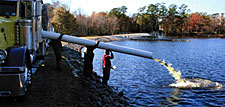
On a trip to Richmond Mill in mid-winter, Buhler took me out to look at the feeders and their platforms. Each feeder was dressed in camo, sitting on an unobtrusive platform, out of the way, doing what feeders do, a few inches above water level. Buhler handed me a rod, with a yellow-green crankbait. 1 was skeptical, "This crankbait, in winter, in tea-colored water?" He said, "Just throw it." He tied on a Senko. and for the next hour before dark we cruised the lake, flogging away. 18 bass later, 1 couldn't peel the smile off my face. The fish looked great, no worse for the travel-wear, and look like they are thriving. As the feeders do their job, it will be another interesting adventure into fisheries management.
Next issue of Pond Boss, read details about the feeders and how the system works, and an update on the fishery. And, if the business model is ready then. I'm sure you will be interested in the ways the Morgan Company intends to put the lake to work.
In the meantime, 1 will continue the treks into the Carolinas, and make sure those fish are doing what fish do.
Stay tuned
Reprinted with permission from Pond Boss Magazine



